Résultats de recherche de titre
Articles 1 à 20 sur 37

The Augsburg Confession (in Latin)
By Philip Melanchthon.

Georgics
By Virgil.

Averroes on Plato's "Republic"
Par Averroes, Ralph Lerner. 1974
"In one fashion or another, the question with which this introduction begins is a question for every serious reader of…
Plato's Republic: Of what use is this philosophy to me? Averroes clearly finds that the Republic speaks to his own time and to his own situation. . . . Perhaps the greatest use he makes of the Republic is to understand better the shari'a itself. . . . It is fair to say that in deciding to paraphrase the Republic, Averroes is asserting that his world--the world defined and governed by the Koran--can profit from Plato's instruction."--from Ralph Lerner's IntroductionAn indispensable primary source in medieval political philosophy is presented here in a fully annotated translation of the celebrated discussion of the Republic by the twelfth-century Andalusian Muslim philosopher, Abu'l-Walid Muhammad Ibn Ahmad Ibn Rushd, also know by his his Latinized name, Averroes. This work played a major role in both the transmission and the adaptation of the Platonic tradition in the West. In a closely argued critical introduction, Ralph Lerner addresses several of the most important problems raised by the work.
This volume offers a new English translation, introduction, and detailed commentary on Sefer Meyasher 'Aqov, (The Rectifying of the Curved), a…
14th-century Hebrew treatise on the foundation of geometry. The book is a mixture of two genres: philosophical discussion and formal, Euclidean-type geometrical writing. A central issue is the use of motion and superposition in geometry, which is analyzed in depth through dialog with earlier Arab mathematicians. The author, Alfonso, was identified by Gita Gluskina (the editor of the 1983 Russian edition) as Alfonso of Valladolid, the converted Jew Abner of Burgos. Alfonso lived in Castile, rather far from the leading cultural centers of his time, but nonetheless at the crossroad of three cultures. He was raised in the Jewish tradition and like many Sephardic Jewish intellectuals was versed in Greek-Arabic philosophy and science. He also had connections with some Christian nobles and towards the end of his life converted to Christianity. Driven by his ambition to solve the problem of the quadrature of the circle, as well as other open geometrical problems, Alfonso acquired surprisingly wide knowledge and became familiar with several episodes in Greek and Arabic geometry that historians usually consider not to have been known in the West in the fourteenth century. Sefer Meyasher 'Aqov reflects his wide and deep erudition in mathematics and philosophy, and provides new evidence on cultural transmission around the Mediterranean.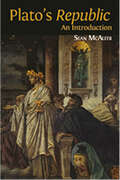
Horos: Ancient Boundaries and the Ecology of Stone
Par Thea Potter. 2022
In Horos, Thea Potter explores the complex relationship between classical philosophy and the ‘horos’, a stone that Athenians erected to…
mark the boundaries of their marketplace, their gravestones, their roads and their private property.
Studies in Rabbinic Hebrew
Par Shai Heijmans. 2020
This volume presents a collection of articles centring on the language of the Mishnah and the Talmud – the most…
important Jewish texts (after the Bible), which were compiled in Palestine and Babylonia in the latter centuries of Late Antiquity. Despite the fact that Rabbinic Hebrew has been the subject of growing academic interest across the past century, very little scholarship has been written on it in English. Studies in Rabbinic Hebrew addresses this lacuna, with eight lucid but technically rigorous articles written in English by a range of experienced scholars, focusing on various aspects of Rabbinic Hebrew: its phonology, morphology, syntax, pragmatics and lexicon. This volume is essential reading for students and scholars of Rabbinic studies alike, and constitutes the first in a new series, Studies in Semitic Languages and Cultures, in collaboration with the Faculty of Asian and Middle Eastern Studies at the University of Cambridge.
Aeneid 8 (The Focus Vergil Aeneid Commentaries)
Par Vergil, James J. O'Hara, Randall Ganiban. 2018
Vergil Aeneid 8 is part of a new series of commentaries on the Aeneid Each volume adapts with…
extensive revisions and additions the commentaries of T E Page 1884 1900 and is edited by a scholar of Roman epic The present volume offers the Latin text of Book 8 along with maps extensive notes and commentary designed to meet the needs of intermediate students of Latin A two-volume edition of the entire Aeneid designed to meet the needs of advanced students will be derived from the series
Epistola ad Joannem Millium
Par G. P. Goold, Richard Bentley. 1962
The year 1962 marks the tercentenary of the birth of Richard Bentley (1662-1742), Master of Trinity College, Cambridge, editor of…
Paradise Lost, but principally and justly famous as one of the greatest classical scholars. To mark the event, the University of Toronto Press is issuing a special reprint of Alexander Dyce's edition of the Epistola (1691), the work which first brought Bentley fame, and which has long been out of print.This Latin exercise was called forth by one of those unhappy productions which, mediocre themselves, have had the ill luck to attract the inspection of genius. In the eighth or ninth century A.D., Joannes Malelas of Antioch, a Greek writer, attempted a chronological record of mankind and in it he had recourse to name or quote from classical works no longer extant. English scholars in the seventeenth century prepared a translation of the chronicle into Latin and an accompanying commentary; just before its publication, under the final editorship of John Mill, Bentley was given an opportunity to read proof-sheets and the result was the Epistola, a collection mainly of some twenty-five notes upon statements found in or topics suggested by Malelas. This extraordinary performance by a scholar of 29 moves from one topic to another over a wide range of ancient literature, explaining or correcting some sixty Greek and Latin authors. The notes are not so much a commentary on the old chronicler as a set of dazzling dissertations pegged upon a random set of appalling howlers, and they reveal prodigious information and gift of divination. Bentley's style in Latin is clear and spirited and seasoned with choice of quotation. The Epistola immediately secured for its writer the fame reserved for men of the rarest excellence and this classic among academic productions is still charged with power to instruct and inspire the scholarship of another era.
Caesar's Commentaries (in Latin)
By Julius Caesar.

Cicero's Orations (in Latin)
By Marcus Tullius Cicero.

Aeneid
By Virgil.

A Student Handbook of Latin and English Grammar
Par Robert Mondi, Peter L. Corrigan. 2014
The study of classical languages by earlier generations of English-speaking students was greatly facilitated by the study of English grammar…
in the schools, a tradition now out of favor but one that emphasized precisely the concepts, terms, and constructions needed for the study of Greek and Latin.A Student Handbook of Latin and English Grammar offers a student-friendly comparative exposition of English and Latin grammatical principles that will prove a valuable supplement to a wide range of beginning Latin textbooks as well as a handy reference for those continuing on to upper-level courses.
A Companion to Familia Romana: Based on Hans Ørberg's Latine Disco, with Vocabulary and Grammar
Par Hans H rberg, Jeanne Neumann. 2016
This volume is the completely reset Second Edition of Jeanne Marie Neumann's A College Companion (Focus, 2008). It offers a…
running exposition, in English, of the Latin grammar covered in Hans H. Ørberg's Familia Romana, and includes the complete text of the Ørberg ancillaries Grammatica Latina and Latin–English Vocabulary. It also serves as a substitute for Ørberg's Latine Disco, on which it is based. As it includes no exercises, however, it is not a substitute for the Ørberg ancillary Exercitia Latina I. Though designed especially for those approaching Familia Romana at an accelerated pace, this volume will be useful to anyone seeking an explicit layout of Familia Romana's inductively-presented grammar. In addition to many revisions of the text, the Second Edition also includes new units on cultural context, tied to the narrative content of the chapter.
A Companion to Roma Aeterna: Based on Hans Ørberg's Instructions, with Vocabulary and Grammar
Par Hans H rberg, Jeanne Neumann. 2017
A sequel to her widely used A Companion to Familia Romana (now in its second edition), Jeanne Marie Neumann's A…
Companion to Roma Aeterna offers a running commentary, in English, of the Latin grammar covered in Hans H. Ørberg's Roma Aeterna, and includes the complete text of the Ørberg ancillaries Grammatica Latina and Latin–English Vocabulary II. It also serves as a substitute for Ørberg’s Instructions, on which it is based. Though designed especially for those approaching Roma Aeterna at an accelerated pace, this volume will be useful to anyone seeking an explicit exposition of that volume's implicitly presented grammar. In addition to many revisions of the text, A Companion to Roma Aeterna also includes new units on cultural context, tied to the narrative content of the chapter.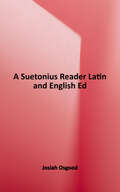
A Suetonius Reader: Selections From the Lives of the Caesars and the Life of Horace
Par Josiah Osgood. 2011
The popular appeal of Suetonius' Lives of the Caesars is obvious. Who would not thrill reading about the great Julius…
Caesar's delight in the Senates bestowal of the right to wear a laurel wreath on all occasions because it covered his baldness? Or that the Divine Augustus had rotten teeth and wore special platform shoes to make himself look taller? Suetonius, however, has not always been as enthusiastically received among historians, who sometimes overlook that he intended his work as biography, not history, or that he patently aimed for prose that was not literary, but instead unadorned, clear, and concise. Such qualities of prose, however, happily make his Latin enjoyable both to teach and to read. And while Suetonius' details of the weird worlds of extraordinary men are endlessly entertaining, they are not merely that. This business like biographer produced an extraordinarily influential work. His Caesars is a landmark in the history of biographical writing, and remains a key source for the history of Rome, its transition from Republic to Empire, and contemporary efforts to come to terms with individual destiny, through astrology, physiognomy, dream analysis, and more. Through to the present day Suetonius has profoundly shaped modern perceptions of Roman society.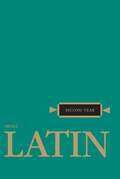
Second Year Latin
Par Robert J. Henle. 1958
The backbone of Henle Latin Second Year is intensive language study, including review of the first year plus new materials.…
Separated into four parts, Henle Latin Second Year includes readings from Caesar's Commentaries, extensive exercises, and Latin-English vocabularies. Humanistic insight and linguistic training are the goals of the Henle Latin Series from Loyola Press, an integrated four-year Latin course. Time-tested and teacher endorsed, this comprehensive program is designed to lead the student systematcially through the fundamentals of the language itself and on to an appreciation of selected classic texts.
Prismatic Jane Eyre: Close-Reading a World Novel Across Languages
Par Matthew Reynolds, Others. 2023
Jane Eyre, written by Charlotte Brontë and first published in 1847, has been translated more than five hundred times into…
over sixty languages. Prismatic Jane Eyre argues that we should see these many re-writings, not as simple replications of the novel, but as a release of its multiple interpretative possibilities: in other words, as a prism. Prismatic Jane Eyre develops the theoretical ramifications of this idea, and reads Brontë’s novel in the light of them: together, the English text and the many translations form one vast entity, a multilingual world-work, spanning many times and places, from Cuba in 1850 to 21st-century China; from Calcutta to Bologna, Argentina to Iran. Co-written by many scholars, Prismatic Jane Eyre traces the receptions of the novel across cultures, showing why, when and where it has been translated (and no less significantly, not translated – as in Swahili), and exploring its global publishing history with digital maps and carousels of cover images. Above all, the co-authors read the translations and the English text closely, and together, showing in detail how the novel’s feminist power, its political complexities and its romantic appeal play out differently in different contexts and in the varied styles and idioms of individual translators. Tracking key words such as ‘passion’ and ‘plain’ across many languages via interactive visualisations and comparative analysis, Prismatic Jane Eyre opens a wholly new perspective on Brontë’s novel, and provides a model for the collaborative close-reading of world literature. Prismatic Jane Eyre is a major intervention in translation and reception studies and world and comparative literature. It will also interest scholars of English literature, and readers of the Brontës.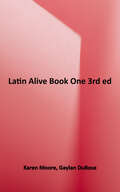
Latin Alive! (Latin Alive Series #Book One)
Par Karen Moore, Gaylan DuBose. 2008
Students will be delighted by what they learn in each new chapter of Latin Alive!, Book One, and they will…
learn to see that Latin is everywhere around them. As the first text in a three-year series, it is a rigorous and thorough introduction to this great language and is designed to engage upper school (middle and high school) student. Brimming with relevant facts and stories this text offers something for everyone. A Teacher’s Edition including answer keys, teacher’s helps and additional activities is available separately.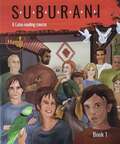
Suburani
Par Hands Up Education. 2020
Excerpt from the back cover: "It's the spring of AD 64 and, as dawn breaks over the Subura in Rome,…
a young woman calls from high in an apartment building to her aunt working in a bar below. While her father collects the rent from the other tenants, a falling tile narrowly misses a senator's son passing through the streets in a litter. Was it an accident? In the Subura, your life hangs by a thread.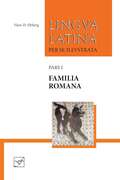
Familia Romana (Lingua Latina #Book One)
Par Hans H. Ørberg. 2011
Hans Ørberg's Lingua Latina per se Illustrata is the world's premiere series for learning Latin via the Natural Method. The…
Natural Method encourages students to learn Latin without resorting to translation, but instead by teaching them to think in the language: students first learn grammar and vocabulary inductively through extended contextual reading and an ingenious system of marginal notes. Lingua Latina per se Illustrata is also the most popular series for those teachers at both the secondary and collegiate levels who wish to develop Latin conversational skills in the classroom. Familia Romana (the main book of Pars I of the Lingua Latina per se illustrata series) contains thirty-five chapters and describes the life of a Roman family in the 2nd century A.D. It culminates in readings from classical poets and Donatus's Ars Grammatica, the standard Latin school text for a millennium. Each chapter is divided into two or three lessons (lectiones) of a few pages each followed by a grammar section (Grammatica Latina) and three exercises (Pensa). Hans Ørberg's impeccable Latin, humorous stories, and the Peer Lauritzen illustrations, reproduced in full color, make this work a classic. The book also includes a table of declensions, a Roman calendar, and a word index (index vocabulorum). The Lingua Latina series incorporates the following features: The most comprehensive treatment of Latin grammar available in an elementary textbook. A vocabulary of almost 1,800 words, reinforced by constant and creatively phrased repetition, vastly expands the potential for later sight reading. A complete line of ancillary volumes, exercises, and readers both in print and online.